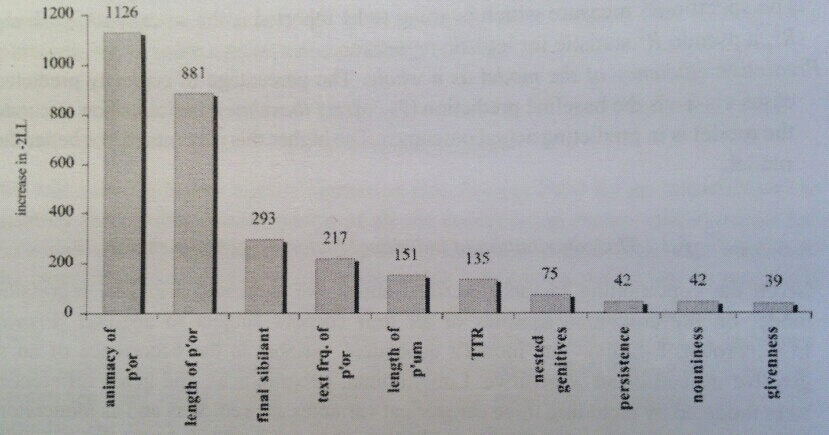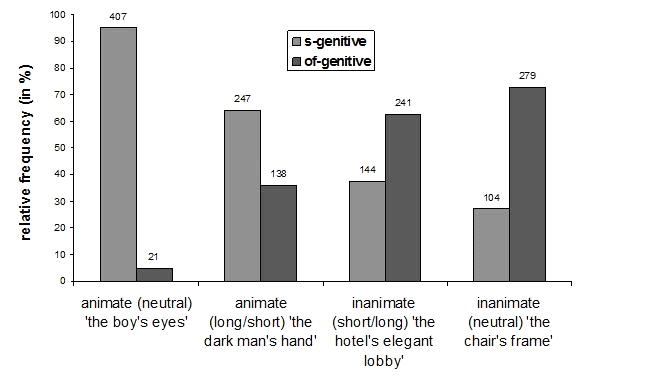A number of factors which affect the genitive choice are listed and discussed above. One question arises: is there a proper hierarchy of their influence, i.e. which factors have stronger influence than other factors? Hinrichs and Szmrecsanyi (2007: 460-464) draw up a logistic regression model on the combined samples from the corpora Brown, LOB, Frown and F-LOB. In this model the dependent variable is the occurrence of an s-genitive. They tested the factors in the model to find out how strong their effects on the genitive choice are compared to each other.

Figure 4 below shows the results:
Figure 4. Increase in -2 log likelihood (decrease in model goodness-of-fit) if factor(s) removed (Hinrichs and Szmrecsanyi 2007: 463)
From figure 4 it can be concluded that among those factors, animacy of possessor has the strongest effect, which is then followed by length of possessor. Yet if the contribution of length of possessor and length of possessum are combined together, the joint effect is close enough to the effect of animacy of possessor. Final sibilant in possessor ranks in third place, economy-related factors like type-token ratio (as “TTR” in figure 4) and “nouniness” contribute in a rather posterior place. According to the results shown in figure 4, Hinrichs and Szmrecsanyi (2007: 464) conclude that the groups of factors should have the following effect hierarchy:
semantics/pragmatics ~ processing/parsing > phonology > economy
Rosenbach’s (2013) study confirms that animacy is more vital than weight in choosing the two genitives through combining elicitation (experimental) data and corpus data. In the elicitation (experimental) study, Rosenbach (2013) designed a questionnaire with authentic text passages containing genitive constructions and avoiding other factors which might affect the choice (such as givenness, possessive relation, final sibilant in possessor and so on). The results are shown in figure 5 below. Then Rosenbach (2013) selected the data from the corpus ICE-GB in the same way as in the elicitation (experimental) study. The results of the corpus study are shown in figures 3a and 3b in the previous section.

Figure 5. Animacy versus weight in the experimental study: relative frequency of the s-genitive and of the of-genitive (number of tokens indicated above each column) (Rosenbach 2013: 287)
In figure 5, animate (long/short) structures occur more frequently with s-genitive than inanimate (short/long) ones (247 versus 144). Hence, animacy is a more important factor than weight. Figures 3a and 3b show that when the word number of the possessor is up to 3 words, animacy has a stronger effect on the genitive choice than weight. The results of Rosenbach’s (2013) elicitation (experimental) study and corpus data accord with each other, and the results are also in accordance with those in the study of Hinrichs and Szmrecsanyi (2007).
Created with the Personal Edition of HelpNDoc: Easily create PDF Help documents